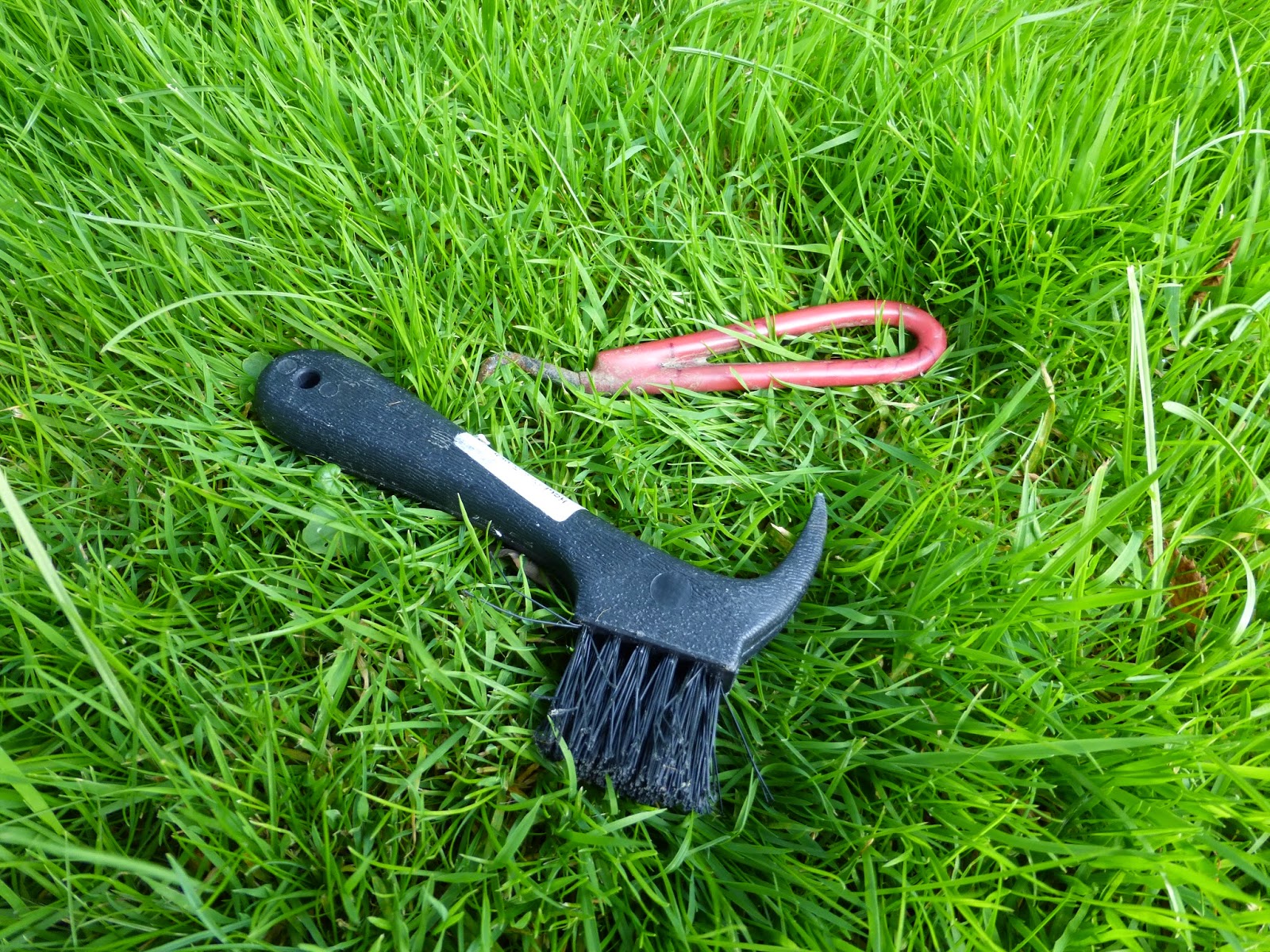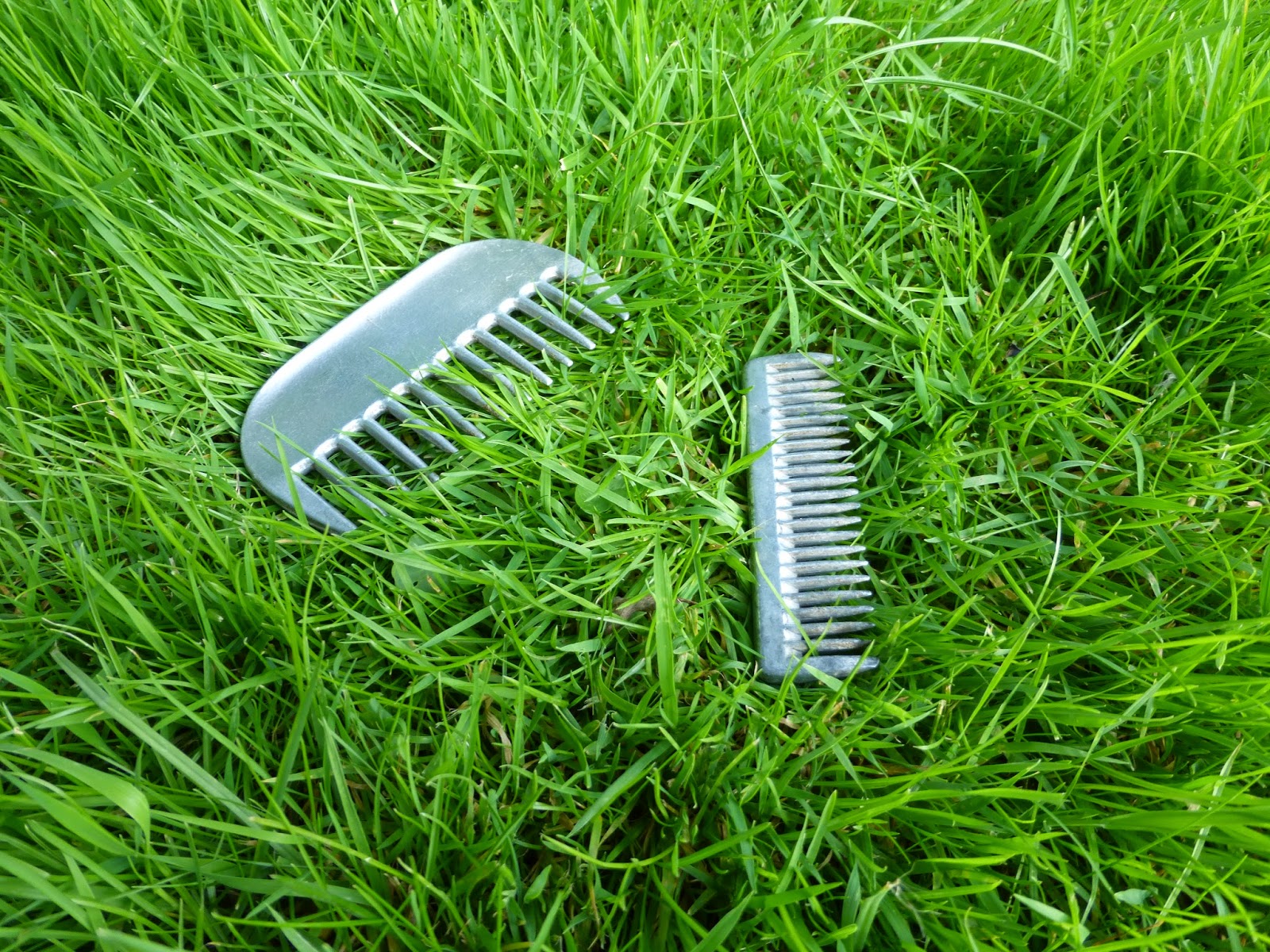Why Groom?
Spending time with your horse is essential to help build
your relationship. Grooming gives you a
great chance to do this. If you watch
horses in the field they will spend time grooming each other, especially other
horses that are their 'friends'.
Obviously there are other reasons for grooming:
- you are keeping the horse clean by removing sweat, grease, dust, dead skin and hair
- you are massaging and therefore increasing blood circulation
- grooming may also help develop muscle and skin tone when done regularly
- grooming can also help prevent skin diseases and infections which are caused by dust and dirt, by removing the dead skin and hair you are discouraging any parasites which feed on these
- it is a good opportunity to inspect for injuries or wounds.
What's in a Grooming Kit?
Hoof pick
For keeping a horses hooves clear of mud, stones and other objects.
For use on an unclipped horse to remove mud and sweat. There are different dandy brushes available
which I have found are suitable for different types of horse. Some have slightly softer bristles which I
find are ideal for thinner skinned horses such as thoroughbreds, like
Baz. The body brush (below) can never
remove the mud we have around here because our soil has a high clay
content. Horses with thicker coats and
less sensitive skins (like Ches and Fidget) need good stiff bristles to
remove the mud.
Body brush
This brush is used on clipped horses and summer coats. The closer finer bristles can clean deeper down through the coat to the skin. I don't like using these brushes on unclipped horses in the winter because I believe they can remove too much of a horses protective and waterproof greases from the coat. Again you can get body brushes with stiffer or softer bristles depending on the horse. These brushes seem to generally have a 'handle' to help keep the brush in your hand when you are grooming.
Water brush
This looks a bit like a Dandy brush but has softer bristles. These tend to be used for damping down manes or tails when needed or for scrubbing out hooves. To be honest I don't use this brush very often, I find the bristles too soft for scrubbing out hooves and rarely damp down manes or tails.
Rubber curry comb
There are 2 uses for this 'brush' either on the horses body or as with the Metal curry comb (see next section).
When used on the horses body it can be useful for removing mud or sweat and for bringing scurf to the surface. The brush should be used in a circular motion and is really good at removing loose hair (especially when horses are moulting). This circular motion also improves circulation to the area. It is important to be gentle on any bony areas and many horses will not tolerate use of this 'brush' under their tummies! Baz is very sensitive and does not like this brush on his back either.
Metal curry comb
This must NEVER be used on a horses body! It is used to remove dirt and grease from the Body brush during grooming. The Body brush should be swept over the curry comb and the metal 'teeth' will take the hairs and grease out of the bristles.
You should hold the handle in the palm of your hand with the body of the brush laid along your wrist, this ensures you do not skin your knuckles. If you sweep the curry comb over the body brush you take the risk of scraping your arm.
Plastic curry combs are also available but I find are less effective for this as the plastic 'teeth' break off too easily. Some people use the plastic versions on manes and tails but I think they are too aggressive for this and break the hairs.
Mane and Tail comb
The larger combs are for combing manes and tails.
The smaller are for pulling manes and tails and to help with
plaiting.
The combs can be made from metal or plastic but I find the plastic
ones don't last very long as the teeth break off as with the plastic curry
comb. When using the combs on the tail
you need to be very careful not to break the hairs and often using fingers is a
better option.
Sponges
One for cleaning the eyes, nose and mouth and one for cleaning the dock area. I also have one for washing off saddle and girth areas in the summer. The best way to keep them separate is to have different colours for different uses but you should also have different ones for different horses.
Hoof oil
There are a huge selection available nowadays, but often vegetable oil eg: Soya, Linseed or Olive will do the same job. You will also need a brush to apply this with. It should be used on clean hooves and can also be applied to the sole.
There are a huge selection available nowadays, but often vegetable oil eg: Soya, Linseed or Olive will do the same job. You will also need a brush to apply this with. It should be used on clean hooves and can also be applied to the sole.
Scissors
There are different sorts of scissors for different jobs. Blunt, curved scissors are used for trimming tails, fetlocks or whiskers (which I DO NOT approve of because they help horses feel objects close to them). Manes should never be trimmed with scissors because it makes them thick and stick up. There are also scissors for keeping in your first aid kit and for specialised jobs.
The wisp or massage pad
Used rarely nowadays as the wisp is now believed when used vigorously can damage muscle fibres and injure a horse. Wisps were made of hay or straw and used with a slapping action on the muscular parts of the neck, shoulders and hindquarters.
Used rarely nowadays as the wisp is now believed when used vigorously can damage muscle fibres and injure a horse. Wisps were made of hay or straw and used with a slapping action on the muscular parts of the neck, shoulders and hindquarters.
Stable rubber
A soft cloth or tea towel can be used for a final wipe over of the horse after grooming to give a final polish to the coat and remove any remaining dust.
Sweat scraper
These are generally used to remove excess water from a horse after washing or bathing, but can be used for a sweaty horse. I find that if Ches is really sweaty then he gets a hose down anyway so I only use the sweat scraper for excess water.
A soft cloth or tea towel can be used for a final wipe over of the horse after grooming to give a final polish to the coat and remove any remaining dust.
Sweat scraper
These are generally used to remove excess water from a horse after washing or bathing, but can be used for a sweaty horse. I find that if Ches is really sweaty then he gets a hose down anyway so I only use the sweat scraper for excess water.
Towels
For drying off a horse after bathing of if they have wet legs. I find I actually use these the most in the winter to dry off heads and necks when they come in soaking from the field. Mine are all old bath towels which now have holes and rips.
Tail bandage
Some times it is useful to apply a tail bandage after grooming to help shape and tidy the horses tail. These tend to be made from elasticated material. They are also used to stop a horse damaging or rubbing their tail whilst travelling, shaping tails after washing, keeping tails up and out of the wet and mud eg: whilst playing Polo or going X-Country. Reflective tail bandages are also available for use when riding on the road. I only really use these for travelling.
Grooming machines
Some big yards have grooming machines which save time and labour. They do tend to be expensive to purchase and they should not be used daily but every 4 to 7 days. I have absolutely no experience with these and feel that for an individual you would miss out too much on the relationship building that grooming allows for.
Some big yards have grooming machines which save time and labour. They do tend to be expensive to purchase and they should not be used daily but every 4 to 7 days. I have absolutely no experience with these and feel that for an individual you would miss out too much on the relationship building that grooming allows for.
Fly repellent and Vaseline are other useful items to keep in
your grooming kit.
Taking care of your grooming kit.
Your kit should always be kept clean and in good repair. Dirty brushes will not clean a horse
sufficiently and may spread disease, cause infections or skin problems. Brushes should be washed regularly in warm
water using mild unscented soap. I tend
to use horse shampoo but this can be an expensive option. Metal parts must be kept clean and dry and
bandages should be washed, dried and rolled ready for use. Sponges should also be cleaned thoroughly
using a mild antiseptic solution.
I give the box a good scrub out and then soak the brushes in a bucket of warm water with soap/shampoo. I then use the rubber curry comb to scrape each brush and give the bristles a good clean.
After rinsing under the tap I prop the brushes up in the sunshine to drip and dry.
And then I have a lovely clean and shiny grooming kit.
Later this week I will be uploading my 'What's in my Grooming Kit' vlog on my new You Tube channel. Horse Life and Love. Please check it out and SUBSCRIBE.
You can also follow me on Facebook for updates on Chesney, Basil, Fidget and Daisy.
I give the box a good scrub out and then soak the brushes in a bucket of warm water with soap/shampoo. I then use the rubber curry comb to scrape each brush and give the bristles a good clean.
After rinsing under the tap I prop the brushes up in the sunshine to drip and dry.
And then I have a lovely clean and shiny grooming kit.
Later this week I will be uploading my 'What's in my Grooming Kit' vlog on my new You Tube channel. Horse Life and Love. Please check it out and SUBSCRIBE.
You can also follow me on Facebook for updates on Chesney, Basil, Fidget and Daisy.
Until next time!
Jo















No comments:
Post a Comment